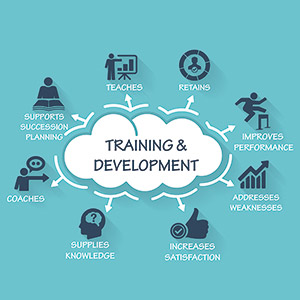What Is HR Training and Development? (Plus Why It’s Important)
Regardless of the industry you’re in, you’ve likely heard of HR learning and development. This process involves providing training and support to employees to improve performance and increase overall company productivity. Implementing this process can help an organization become a more attractive employer and differentiate itself from the competition. In this article, we elaborate on what HR training and development is and explain how to create an effective plan for your performance.
What is HR training and development?
HR training and development is human resources process that seeks to optimize employee performance. Strategies can involve teaching employees how to use new technology, rating individual and group performances and using evaluations to develop more efficient processes. HR training and development also promotes the company’s culture to create a safe and positive work environment. In addition to advancing employees’ careers, the goal of HR training and development is to improve the overall productivity of a company.
Why is HR training and development important?
Here are a few reasons it’s important for companies to invest in good HR training and development programs:
Increased employee retention
Whether they have years of experience or are new to the industry, employees often depend on their companies for support. This includes a job description, transparency and training to ensure that they can successfully perform their duties. By implementing a good HR training and development program, an organization can demonstrate its commitment to its staff. This proactiveness helps increase employee retention by establishing a support system. Other benefits include increased staff stability and lower rehiring and retraining costs.
Improved employee performance
HR training and development sets employees up for success by helping them build essential skills. Good programs measure progress and develop solutions to address areas of improvement, meaning everyone improves their performance. Other positive outcomes include the ability to meet deadlines, demonstrate leadership and submit high-quality work that adheres to company goals and increases customer satisfaction.
Increased company productivity
When everyone works more efficiently, it increases overall company productivity. Many HR training and development programs reduce mundane tasks and direct employee efforts to more creative endeavors. This innovation can lead to better profits by increasing customer satisfaction and surpassing the competition. As a result, the company experiences growth and creates attractive opportunities for employees like raises and additional benefits.
Improved company culture
An HR training and development programs usually strive to create a positive company culture. By enforcing values like integrity, teamwork and communication, a company can promote itself as a good place to work. The result is a good reputation among its customers and talented professionals who are seeking employment.
Difference between HR training vs. development
HR training and development is often a cohesive process, but there are some key differences between the two terms. “Training” usually refers to short-term procedures that directly relate to an employee’s job description. For instance, employees might complete a formal course to learn how to use a new technology that their company adopted. “Development” tends to be broader with long-term goals of advancing an employee’s career and innovating in one’s industry. For instance, a company that prepared entry-level employees for eventual internal promotions would be focusing on development rather than training.
How to create an HR training and development process
Here’s how to create an HR training and development process:
1. Understand the organization’s goals
Good HR training and development processes coincide with the organization’s goals. This approach ensures you can justify the cost of the programs and facilitates the company’s growth. You can consider short- and long-term goals when creating different facets of your plan. For instance, if your organization wants to promote staff members internally, it might gradually introduce new responsibilities to prepare employees for a new role. If your organization wants to increase sales in the next five years, it might focus on researching the latest lead-generation technology and teaching employees how to use it.
2. Conduct employee surveys
Even if they’re in the same industry, employees can have vastly different learning styles. Some might prefer formal instruction via classroom lectures and testing. Others are more receptive to coaches and peer mentors who provide informal instruction. You can create a survey to understand which techniques would be most effective and even cater to instructional methods to individual employees.
3. Choose the appropriate methods
You can choose the appropriate training and development methods by considering the organization’s goals and survey results. You might also decide how often to implement them to ensure results. For instance, a company that wants to increase its online presence might ensure all employees are familiar with different social media platforms.
This integrative approach allows team members from different departments to contribute unique ideas on how to boost the company’s following. Because of the constantly evolving nature of social media, the company might deem it necessary to conduct training sessions at least once per month. A more stagnant issue might only require annual sessions or sessions whenever a recurring problem arises.
4. Prepare supervisors
After developing their programs, HR departments ensure supervisors have the resources to implement them effectively. Supervisors may undergo additional training to ensure they can present the material in an accessible way. They might also require additional resources, like textbooks and computers, to help employees develop their workplace skills.
5. Monitor results
As much planning as an HR department puts into a training and development plan, they can only know if it’s successful by monitoring results. There are several ways to monitor results, such as conducting employee surveys or reviewing test scores. You might also determine the percentage of employees who receive a certification or promotion as a result of training. By monitoring results, you can determine if the program is successful and make any necessary adjustments.





